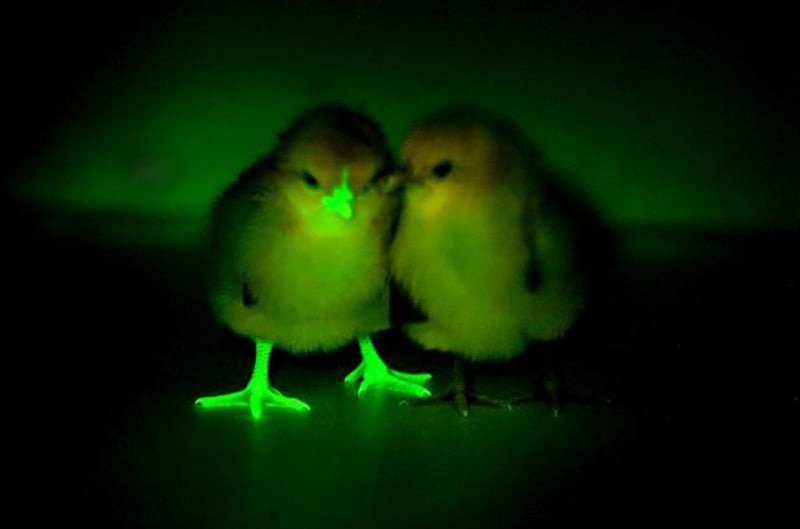发布时间:2024-02-26 10:36:23 人气:1462 来源:析浦科学仪器
绿色荧光蛋白的GFP(Green fluorescent protein)的第65至67位的三个氨基酸(丝氨酸-酪氨酸-甘氨酸)残基,可自发地形成一种荧光发色团。当蛋白质链折叠时,这段被深埋在蛋白质内部的氨基酸片段,得以“亲密接触”,导致经环化形成咪唑酮,并发生脱水反应。在分子氧存在的条件下,发色团可进一步发生氧化脱氢,最终成熟,形成可发射荧光的形式。具体过程为:在 O2存在下,GFP分子内第67位甘氨酸的酰胺对第65位丝氨酸的羧基进行亲核攻击,形成第5位碳原子咪唑基;第66位酪氨酸的α2β键脱氢反应之后,导致芳香团与咪唑基结合,并最终自发催化形成对羟基苯甲酸咪唑环酮生色。
GFP需要在氧化状态下产生荧光,强还原剂能使GFP转变为非荧光形式,但一旦重新暴露在空气或氧气中,GFP荧光便立即得到恢复。一般来说弱还原剂并不会影响GFP荧光,中度氧化剂如生物材料的固定,脱水剂戊二酸或甲醛等对GFP荧光影响也不大。

绿色荧光蛋白的GFP吸收的光谱更大峰值为395nm(紫外),并有一个峰值为470nm的副吸收峰(蓝光);发射光谱更大峰值为509nm(绿光),并带有峰值为540nm的侧峰(Shouder)。虽然450~490nm只是GFP的副吸收峰,但由于该激发光对细胞的伤害更小,因此通常多使用该波段光源(多为488nm)。此外,GFP的光谱特性与荧光素异硫氰酸盐(FITC)很相似,两者通常共有一套滤光片。GFP荧光极其稳定,在激发光照射下,GFP抗光漂白(Photobleaching)能力比荧光素强,特别是在450~490nm蓝光波长下更稳定。类似的,GFP融合蛋白的荧光灵敏度远比荧光素标记的荧光抗体高,抗光漂白能力强,因此更适用于定量测定与分析。由于GFP荧光的产生不需要任何外源反应底物,因此GFP作为一种广泛应用的活体报告蛋白,其作用是任何其它酶类报告蛋白无法比拟的。但因为GFP不是酶,荧光信号没有酶学放大效果,因此GFP灵敏度可能低于某些酶类报告蛋白,比如萤火虫荧光素酶等。
广泛应用于分子标记,体内示踪,信号转导,药物筛选等生物科研的各个方面。
诺贝尔奖:
由于GFP的广泛应用以及在生命科学科研中发挥的巨大作用,2008年诺贝尔化学奖授予了,发现并发展了绿色荧光蛋白(GFP)的三位科学家,分别是日本科学家Osamu Shimomura(下村修)、美国哥伦比亚大学的Marin Chalfie以及加州大学圣地亚哥分校的Roger Y.Tsien(钱永健,钱学森堂侄)。
析浦科学仪器有限公司生产有便携式荧光蛋白检测手电筒,无需荧光显微镜,通过荧光手电筒照射转基因植物就可以凭肉眼检测观察绿色荧光蛋白有没有表达,简单方便快捷观察荧光蛋白的表达。产品详细介绍请浏览:手持式GFP荧光手电筒GFPfinder-2101
The very aptly named green fluorescent protein — or GFP as it is almost universally known — is a barrel-shaped protein made up of 238 amino acids. Threaded through the long axis of the β-sheet barrel is an α-helix that contains a chromophore that is responsible for the emission of green light when GFP is exposed to either blue or ultaviolet light. This particular property, coupled with the fact that GFP is well tolerated by many different organisms, has led to its use as a fluorescent tag for monitoring biological processes at the cellular level.
The story of GFP begins in the oceans with the jellyfish Aequorea victoria, which has the unusual property that its outer edges glow green when it is agitated. In the early 1960s, Osamu Shimomura collected raw material from thousands of these jellyfish and extracted a small amount of a blue luminescent protein, which was subsequently named aequorin. During this process he also found another substance that glowed green when exposed to ultraviolet light — this was the protein that later became known as GFP. Shimomura and colleagues went on to show that the green glow produced by the jellyfish arises from an energy-transfer process in which the aequorin donor excites the GFP acceptor, which then emits green light.
In the early 1990s, Martin Chalfie and co-workers demonstrated that GFP could be expressed in organisms other than Aequorea victoria — such as Escherichia coli and Caenorhabditis elegans — and this was the breakthrough that paved the way for the practical implementation of GFP as a fluorescent tag for studying biological processes. It was generally thought that a number of steps requiring other proteins would be needed to produce the chromophore in GFP, but these experiments proved this to be wrong. Significantly, this result meant that GFP could be used as a universal tag, because no other auxiliary agents were needed to induce fluorescence. By engineering the genetic machinery of C. elegans so that it would produce GFP when a protein with a specific activity was expressed inside a cell, Chalfie was able to see cellular processes in a whole new light — albeit a green one!
The further development of GFP was based on a greater understanding of the molecular structure of the protein and specifically the chromophore responsible for its colourful name. Roger Tsien and co-workers explained how three amino acids in the peptide backbone of GFP — namely serine, tyrosine and glycine in positions 65, 66 and 67, respectively — react in the presence of oxygen to form the fluorescent chromophore p-hydroxybenzylideneimidazolinone. With this more detailed description of GFP, Tsien went on to develop other GFP derivatives with different spectral characteristics and increased stability. Not only could the brightness of the fluorescence be enhanced, but also the colour of emission could be tuned. Today all the colours of the rainbow can be found in a range of GFP and GFP-like proteins.
Apart from the obvious biomedical implications, GFP sensors have also been developed that can detect chemical species such as metals ions and small molecules. So not only has GFP enabled scientists to see biological processes in a whole new light, but many other chemical opportunities await. The future for GFP is a bright one.